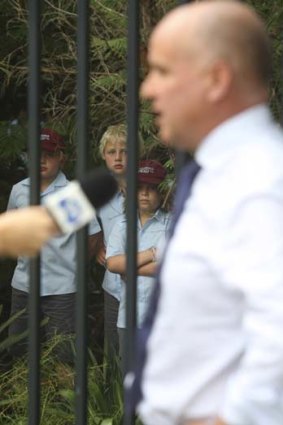By Andrew Stevenson
THE NSW teaching workforce is set for its biggest overhaul in decades, with nearly 20,000 new teachers to be employed in the next five years.
Baby boomer retirements among public school teachers are expected to peak in 2014, when 2136 teachers are expected to leave. More than 3000 new teachers will be employed that year, say figures from the NSW Education Department, and will remain high at least until 2016.

Overhaul ... NSW Education Minister Adrian Piccoli is deregulating school staffing structures in anticipation of baby boomer retirements.Credit: Robert Peet
The flood of new teachers - up by 66 per cent compared with 2010 recruits - comes at the same time as control over staffing is handed to principals under reforms being prepared by the Education Minister, Adrian Piccoli.
The NSW Teachers Federation claims the Local Schools, Local Decisions reform package will allow principals to replace long-serving permanent teachers with recent graduates who could be hired as casuals or on short-term arrangements.
''What we will have is a totally deregulated staffing structure, with an increasing number of temporary positions, no incremental pay scale and no guaranteed executive structure,'' said the federation secretary, Maurie Mulheron.
''The department and the minister see this as a golden time. They can exploit the fact there are a lot of young people coming in and a cheaper workforce. But they can also change the culture by putting them on short-term or casual arrangements. We're extremely worried about the future of the profession.''
Mr Mulheron said salaries, which typically account for 85 per cent of the budget in public schools, are the only way to secure significant savings in the education budget.
Mr Piccoli said the suggestion of widespread casualisation of the teaching workforce was ''unfounded, irresponsible and untrue''. ''The reforms will not affect teacher tenure nor will teachers be placed on individual contracts,'' he said.
''From time to time there is a need for schools to employ a temporary teacher to help meet the specific needs of a particular cohort of students, or to assist with a particular initiative. Under Local Schools, Local Decisions, schools will have the flexibility to organise a temporary position at their school.''
The department already struggles to fill some maths, science and technology teacher positions, despite having 33,000 names on a list of approved teacher applicants.
Five thousand new teachers graduate from NSW universities each year.
Chris Cawsey, the president of the NSW Secondary Principals Council, said the turnover of staff ''will really change the face of education''.
''One of the challenges will be the need for long-term professional development for the new teachers, particularly in terms of teaching and learning skills,'' she said.
''The upside is you get a very young staff who are very skilled with technology and handy with online learning.''
But Ms Cawsey, the principal at Rooty Hill High, noted a less experienced workforce would offer major savings. Her school has been at the forefront of change and already 60 out of 80 staff have less than five years' teaching experience.
When compared to average salary costs across the department, those new graduates represent a saving of nearly $700,000, Ms Cawsey said.
''It is vital that any savings that come from the change of staff are returned to schools and not to Treasury,'' Ms Cawsey said. ''This isn't the time to squib on school funding. It would be nuts not to reinvest the saving.''